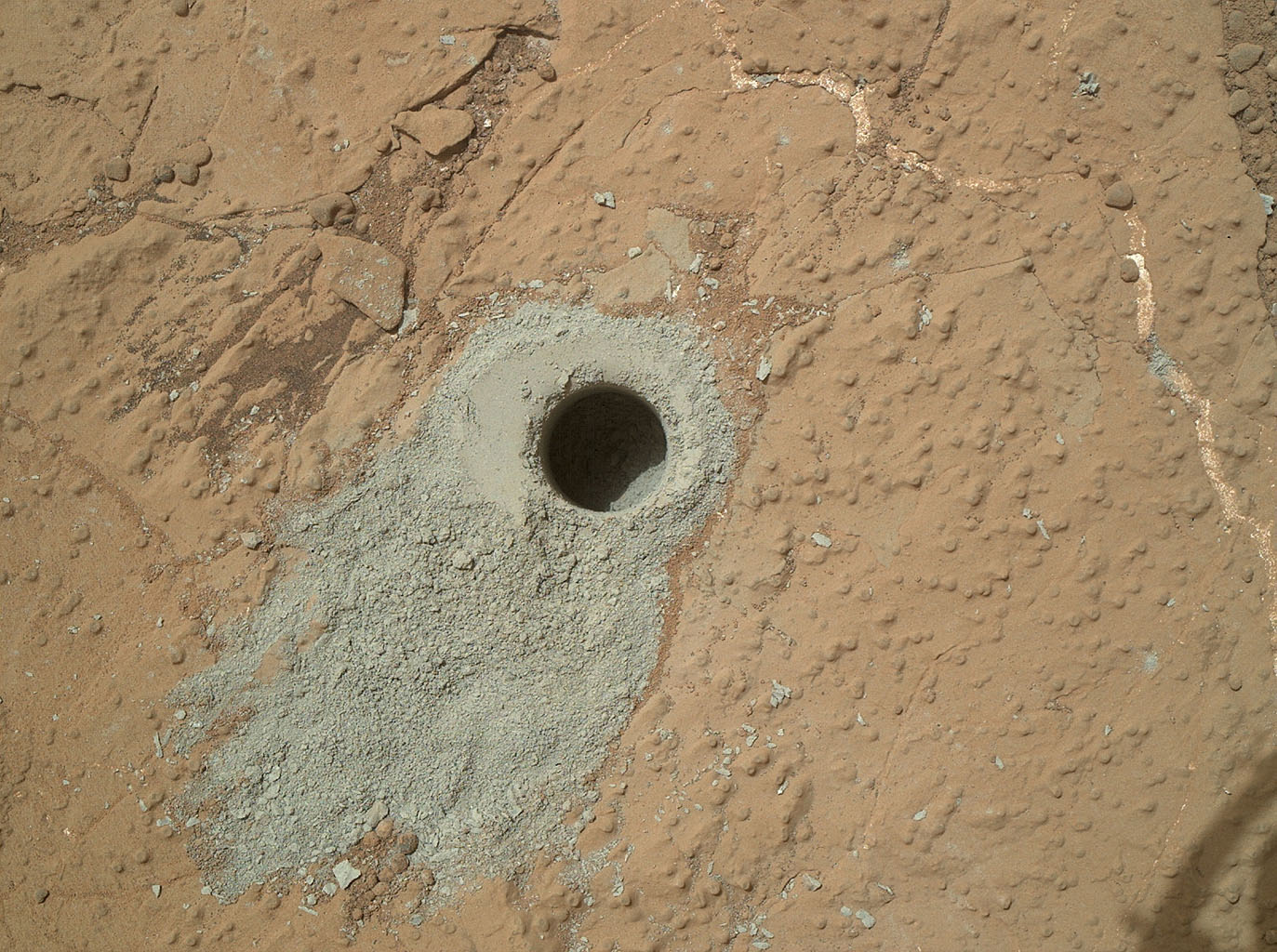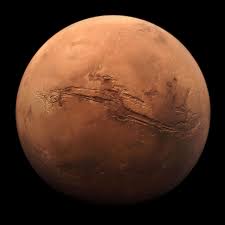Mars is a dry, desert world devoid of any life (that we know of). But once upon a time, that wasn’t the case. Data collected by the robotic emissaries we’ve sent to explore the planet on our behalf indicate that the red planet was once a lush and wet world.
However, scientists are still trying to piece together Martian history to understand what happened to the planet’s water. While we know much of it was lost when the planet’s atmosphere was stripped away, what we don’t know is where the water originated from. Researchers uncovered a crucial clue in Martian meteorites found here on Earth.
“A lot of people have been trying to figure out Mars’ water history,” Jessica Barnes, an assistant professor of planetary sciences in the University of Arizona Lunar and Planetary Laboratory, said in a statement. “Like, where did water come from? How long was it in the crust (surface) of Mars? Where did Mars’ interior water come from? What can water tell us about how Mars formed and evolved?”

Like the Earth, Mars is made of different layers: a crust, mantle, and a core. Meteorites, like the ones that fell to Earth, are made of the Martian crust, which can tell us a lot about the planet’s composition when the pieces are analyzed. According to a study published this week in Nature Geoscience, there could be at least two distinct reservoirs of ancient water lurking below the Martian surface. Each with its own (different) chemical signature.
This means that Mars probably never had a global ocean of magma beneath its surface like we do on Earth.
For this study, Barnes and her team looked for clues as to the Mars’ water history by analyzing the ratio of two types (isotopes) of hydrogen. They’re not the first to do so, but previous results have been very inconsistent.
To better understand how the planet formed and where its water came from, the researchers examined two different meteorites: a coin-sized sample known as Black Beauty (or NWA 7034), which formed when a huge impact cemented together various pieces of the Martian crust, and Allan Hills 84001 (ALH84001), a sample once thought to contain Martian microbes. The data shows that water comes from two different sources.

The team was searching for different isotopes of hydrogen — light hydrogen and heavy hydrogen — which can help trace the origin of water in rocks. (Isotopes are variations of chemical elements, with different numbers of neutrons.)
“Light hydrogen” contains one proton (and no neutrons) in its nucleus, whereas “heavy hydrogen,” also known as deuterium, contains one proton and one neutron in its core. The ratio of these two isotopes act like a fossil record of water, telling a planetary scientist its origin.
Here on Earth, protium (or light hydrogen) is the most abundant isotope. It’s found in the atmosphere, in rocks, and the ocean. On Mars, however, deuterium (heavy hydrogen) is the most abundant in the atmosphere, while Martian rocks contain a range of ratios from Earth-like to Mars-like.
To better understand the vast variation, Barnes and her team decided to focus on samples they knew came from the Martian crust — Black Beauty and Alan Hills. The team found that both samples interacted with water at different point in Mars’ history, but had similar isotope ratios, that was very similar to younger rocks analyzed by the Curiosity rover.

This data suggested a surprising result: that the chemical composition of that water hasn’t changed for nearly 4 billion years.
“Martian meteorites basically plot all over the place, and so trying to figure out what these samples are telling us about water in the mantle of Mars has historically been a challenge,” Barnes said.”The fact that our data for the crust was so different prompted us to go back through the scientific literature and scrutinize the data.”
So the team compared their results to previous isotope studies, where the meteorites originated in the Martian mantle. They discovered that the isotope ratios were consistent with two types of volcanic rock, known as shergottite, that’s found in the Martian mantle.

This means that the water within the meteorite samples came from two different sources. It also indicates that Mars lacked a global magma ocean, which would have made the mantle more consistent in its composition.
“These two different sources of water in Mars’ interior might be telling us something about the kinds of objects that were available to coalesce into the inner, rocky planets,” Barnes said.
Meaning two distinct planetary precursors with vastly different water contents could have collided, but never thoroughly mixed. And understanding how Mars formed is essential for understanding its past habitability and potential for life.

News
Tesla FSD fleet is nearing 7 billion total miles, including 2.5 billion city miles
As can be seen on Tesla’s official FSD webpage, vehicles equipped with the system have now navigated over 6.99 billion miles.

Tesla’s Full Self-Driving (Supervised) fleet is closing in on almost 7 billion total miles driven, as per data posted by the company on its official FSD webpage.
These figures hint at the massive scale of data fueling Tesla’s rapid FSD improvements, which have been quite notable as of late.
FSD mileage milestones
As can be seen on Tesla’s official FSD webpage, vehicles equipped with the system have now navigated over 6.99 billion miles. Tesla owner and avid FSD tester Whole Mars Catalog also shared a screenshot indicating that from the nearly 7 billion miles traveled by the FSD fleet, more than 2.5 billion miles were driven inside cities.
City miles are particularly valuable for complex urban scenarios like unprotected turns, pedestrian interactions, and traffic lights. This is also the difference-maker for FSD, as only complex solutions, such as Waymo’s self-driving taxis, operate similarly on inner-city streets. And even then, incidents such as the San Francisco blackouts have proven challenging for sensor-rich vehicles like Waymos.
Tesla’s data edge
Tesla has a number of advantages in the autonomous vehicle sector, one of which is the size of its fleet and the number of vehicles training FSD on real-world roads. Tesla’s nearly 7 billion FSD miles then allow the company to roll out updates that make its vehicles behave like they are being driven by experienced drivers, even if they are operating on their own.
So notable are Tesla’s improvements to FSD that NVIDIA Director of Robotics Jim Fan, after experiencing FSD v14, noted that the system is the first AI that passes what he described as a “Physical Turing Test.”
“Despite knowing exactly how robot learning works, I still find it magical watching the steering wheel turn by itself. First it feels surreal, next it becomes routine. Then, like the smartphone, taking it away actively hurts. This is how humanity gets rewired and glued to god-like technologies,” Fan wrote in a post on X.
News
Tesla starts showing how FSD will change lives in Europe
Local officials tested the system on narrow country roads and were impressed by FSD’s smooth, human-like driving, with some calling the service a game-changer for everyday life in areas that are far from urban centers.

Tesla has launched Europe’s first public shuttle service using Full Self-Driving (Supervised) in the rural Eifelkreis Bitburg-Prüm region of Germany, demonstrating how the technology can restore independence and mobility for people who struggle with limited transport options.
Local officials tested the system on narrow country roads and were impressed by FSD’s smooth, human-like driving, with some calling the service a game-changer for everyday life in areas that are far from urban centers.
Officials see real impact on rural residents
Arzfeld Mayor Johannes Kuhl and District Administrator Andreas Kruppert personally tested the Tesla shuttle service. This allowed them to see just how well FSD navigated winding lanes and rural roads confidently. Kruppert said, “Autonomous driving sounds like science fiction to many, but we simply see here that it works totally well in rural regions too.” Kuhl, for his part, also noted that FSD “feels like a very experienced driver.”
The pilot complements the area’s “Citizen Bus” program, which provides on-demand rides for elderly residents who can no longer drive themselves. Tesla Europe shared a video of a demonstration of the service, highlighting how FSD gives people their freedom back, even in places where public transport is not as prevalent.
What the Ministry for Economic Affairs and Transport says
Rhineland-Palatinate’s Minister Daniela Schmitt supported the project, praising the collaboration that made this “first of its kind in Europe” possible. As per the ministry, the rural rollout for the service shows FSD’s potential beyond major cities, and it delivers tangible benefits like grocery runs, doctor visits, and social connections for isolated residents.
“Reliable and flexible mobility is especially vital in rural areas. With the launch of a shuttle service using self-driving vehicles (FSD supervised) by Tesla in the Eifelkreis Bitburg-Prüm, an innovative pilot project is now getting underway that complements local community bus services. It is the first project of its kind in Europe.
“The result is a real gain for rural mobility: greater accessibility, more flexibility and tangible benefits for everyday life. A strong signal for innovation, cooperation and future-oriented mobility beyond urban centers,” the ministry wrote in a LinkedIn post.
News
Tesla China quietly posts Robotaxi-related job listing
Tesla China is currently seeking a Low Voltage Electrical Engineer to work on circuit board design for the company’s autonomous vehicles.

Tesla has posted a new job listing in Shanghai explicitly tied to its Robotaxi program, fueling speculation that the company is preparing to launch its dedicated autonomous ride-hailing service in China.
As noted in the listing, Tesla China is currently seeking a Low Voltage Electrical Engineer to work on circuit board design for the company’s autonomous vehicles.
Robotaxi-specific role
The listing, which was shared on social media platform X by industry watcher @tslaming, suggested that Tesla China is looking to fill the role urgently. The job listing itself specifically mentions that the person hired for the role will be working on the Low Voltage Hardware team, which would design the circuit boards that would serve as the nervous system of the Robotaxi.
Key tasks for the role, as indicated in the job listing, include collaboration with PCB layout, firmware, mechanical, program management, and validation teams, among other responsibilities. The role is based in Shanghai.
China Robotaxi launch
China represents a massive potential market for robotaxis, with its dense urban centers and supportive policies in select cities. Tesla has limited permission to roll out FSD in the country, though despite this, its vehicles have been hailed as among the best in the market when it comes to autonomous features. So far, at least, it appears that China supports Tesla’s FSD and Robotaxi rollout.
This was hinted at in November, when Tesla brought the Cybercab to the 8th China International Import Expo (CIIE) in Shanghai, marking the first time that the autonomous two-seater was brought to the Asia-Pacific region. The vehicle, despite not having a release date in China, received a significant amount of interest among the event’s attendees.









